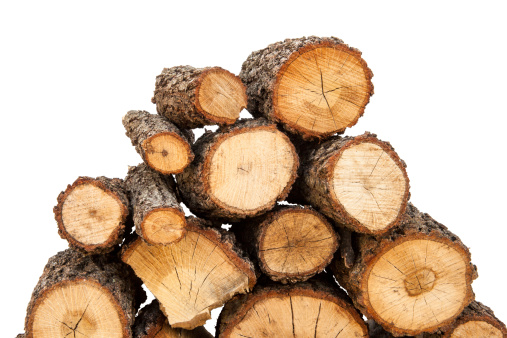by Paul Bianchina
Firewood is a valuable commodity, whether you use it as your exclusive heat source, as supplemental heat, or just for occasional background ambience.
To ensure that you’re getting the most out of your investment, it pays to take the time to store and handle it properly.
If you purchase firewood, there are two things you want to be sure of — dry wood and honest measurements. Firewood is sold in a standard unit of measurement called a cord, which is a uniform stack of wood that measures four-feet high by four-feet deep by eight-feet long (128 cubic feet). Since firewood is irregular in shape, the stack is understood to also include the air spaces between the pieces.
Ideally, your dealer will deliver the wood in a truck that makes verification easy, such as a pickup truck with a four-foot by eight-foot bed and firewood that is stacked four-feet high. “Stacked” is a key word here as well, since that same pickup bed filled with a sloping pile of wood that’s just been tossed in may contain only three-quarters of a cord or less.
Dry wood
The other thing to look for is dry wood. Wood that has just been cut can have a moisture content of 40 per cent or more, so that when you burn it, much of the heat energy it produces is utilized in evaporating the wood’s moisture. When you order your wood, ask when it was cut. If you plan on using the wood this winter, it should have been cut early in the previous spring — earlier than that if possible — and stacked to allow it to air dry and cure through the summer.
Ideally, you want wood that has a moisture content of around 20 per cent. If you burn a lot of wood and rely on it for most of your home heat, it might be worth investing in a moisture meter so that you can check the wood more accurately.
In lieu of a meter, you’ll want to visually inspect the wood that you buy. Dry wood will feel light when you lift it, and will have loose bark, darkened ends with clearly visible splits, and will make very definite “thunking” noise when you hit two pieces together. Wet wood will have just the opposite characteristics, and will sound dull and heavy when knocked together.
Storage and seasoning
Once you have your wood, you need a place to store it. Typically, a good portion of your wood supply will be stored outside where it can continue to dry and season, while a smaller portion will be stored where it’s accessible and ready for use.
Long-term storage areas should be located outside where wind and sun can get to the wood to aid the drying process, and, to minimize danger in the event of a wildfire, should not be stacked directly up against your house. Wood that is left out in the elements, even if it’s dry, will re-absorb water from rain, snow, and from the ground, causing it to become too wet to burn efficiently and, eventually, to rot.
Ideally, you would want to create a dedicated outdoor storage shed for your wood. The shed should have a raised floor to lift the wood off the ground, a roof to keep the elements at bay and open sides to allow unimpeded air circulation. It should be large enough to hold a year’s worth of wood, which is two to four cords for most people, depending on your burning habits, and should be reasonably accessible to the house.
After the wood is dry, most people create a smaller storage area inside the house, such as in the garage or basement. This keeps the wood dry and protected, and allows for easy gathering without having to go outside. Depending on your habits and the accessibility of your outside supply, the inside supply could be as small as two or three days’ worth, or large enough to accommodate several weeks of wood.
Finally, create some storage right at the fireplace or wood stove. One very nice solution is a canvas carrying bag with enclosed ends and sides. The wood is stacked in the bag for carrying, then the bag hooks over a decorative metal frame next to the fireplace for storage, and the wood remains contained within the bag to minimize mess.
Wood box
Another mess-containing solution is a decorative metal tub or a homemade wood box, both of which will hold one or two nights’ worth of wood while keeping the dirt and chips off the carpet. While not quite as neat, there are also a number of very attractive open metal storage racks offered by various manufacturers.
Finally, be very careful that any wood you store inside is far enough away from the fireplace that it cannot combust, and never store newspaper, small kindling, pinecones or other easily combustible materials next to your fireplace.
— Inman News.



